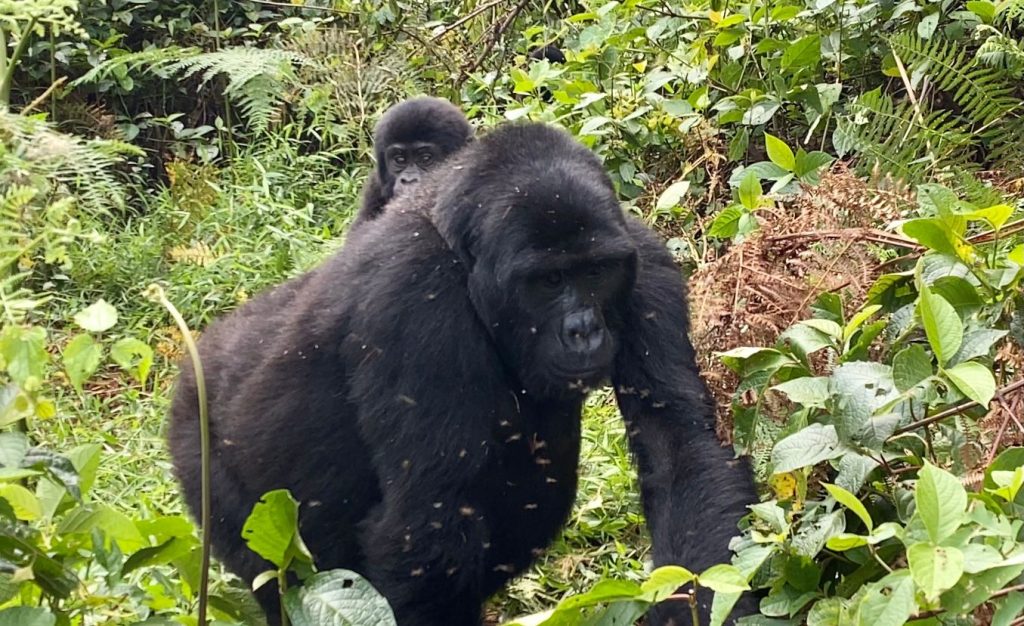What you need to know about gorilla trekking in Uganda
- Home
- What you need to know about gorilla trekking in Uganda
What you need to know about gorilla trekking in Uganda


The mountain gorillas, scientifically referred to as gorilla beringei beringei are only found in Bwindi Impenetrabel national park. The critically endangered species was once at the verge of extinction, due to human activities like poaching, however intense government effort has seen the gorilla population rise to over 500 individuals in Uganda, which is host more than half of the entire gorilla population in the wild. Mountian gorillas survive at high altitudes with an elevation of between 8,000 to 13000 feet above sea level, hence the name mountain gorillas
In Uganda, mountain gorillas are exclusively located in the tropical forest of Bwindi Impenetrabel National Park and Mgahiaga Gorilla National Park.
The impenetrable forest of Bwindi, located in the southwestern region of Uganda in the district of Kanungu is host to majority of ape population scattered across four sectors of the park.
This national park was divided into four sectors, namely Nkuringo in the south, Rushaga in the southwest, Ruhija in the east and Buhoma sector in the north, which all together host nineteen habituated families of gorillas.
Mgahinga Gorilla national park has got over 80 gorillas but only one gorilla family has been fully habituated. Nyakagezi gorilla group in Mgahinga was a migratory group that would cross over to Rwanda and Uganda but have since 2012, settled permanently in Uganda.
Social Life Of Gorillas:
Gorillas are highly social animals which live in groups of 2-40 individuals commonly referred to as a troop or family. A gorilla troop is headed by a male silver back due to the silver hair on its back and flank. A fully-grown male turns to a silver back at the age of twelve years. Other members of the family may include a black back, age eight years, several females, and their young ones. The silver back is responsible for leading the troop in searching for food, protecting the group against invasions by other groups. Troop take overs by a black back or rival group are a very common occurrence in the lives of gorillas. Therefore, the aging of a silverback is the rising fortune of a black back.
Gestation Period & Life Span :
The gestation period of a gorilla is 8.5 months and infants weigh between 1.4-1.8 kg. In July to August 2020, Uganda experienced a baby boom of gorillas with a record six births. This baby boom was attributed to the Uganda Wildlife’s Authority’s effort in conservation of the formerly “critically endangered species” but remain endangered as per the Union for Conservation of Nature. The gorillas were removed from the list of the critically endangered species in 2018; however, they are still categorized as “endangered species” by the Union.
Gorillas are known to have a long life span of up to 50 years when in the wild, though they rarely survive in captivity. Ruhondeza was the oldest silver back in Uganda from Mubare family in Buhoma sector, and died at the age of 50 years in 2012.
The Diet of Gorillas:
Gorillas are majorly vegetarian, feed on things like shoots, roots, stems, and on rare occasions, they may eat snails. They spend much of the day eating, traversing an area of about 0.75 square kilometers. At dusk, they make nests on the ground from leaves, grass and other soft plant materials where they spend the night. Mothers usually sleep with their babies to protection and warmth. The nests are not permanent as gorillas find a new nesting place every evening.
Gorilla Trekking In Uganda
Whereas Uganda is immensely gifted with many tourist attractions, its gorilla trekking experience is an exceptionally rewarding adventure of the wild. Bwindi impenetrable national park is the most popular gorilla trekking destination in Uganda. Trekking mountain gorillas through the thick forest upon rugged slopes is a six-hour long adventure, with a maximum of one hour to observe the gentle apes in their realm.
Trekking Permits In Uganda
For USD 700 per foreign nonresident, a tourist gets a chance of lifetime to admire the ways of these endangered species in their natural environment. It is advised to book your gorilla permit through a licensed tour operator and at least six months in advance, as demand for the permits exceeds the available slots. East African citizens pay UGX 250,000/= per person, for the same permit.
Maximum of 8 people are allowed to trek a single gorilla group per day therefore given the number of families in Uganda, 80 permits are issued every day.
When Is The Best Time To Trek Gorillas In Uganda?
Gorilla trekking is best under taken during dry seasons, between the months of June to September and December to February. These forest trails are dry and slopes less slippery thus allowing the visitor to focus their energy more on the adventurous trek than how to go about un navigable terrain.
However, dry seasons attract most tourist numbers which necessitates high competition for services like accommodation and activity prices.
Mgahinga Gorilla national park has got over 80 gorillas but only one gorilla family has been fully habituated. Nyakagezi gorilla group in Mgahinga was a migratory group that would cross over to Rwanda and Uganda but have since 2012, settled permanently in Uganda.
